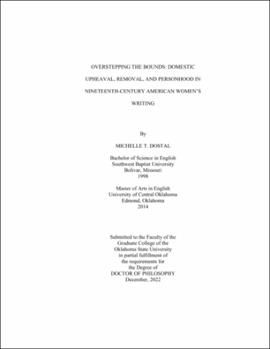| dc.contributor.advisor | Decker, William M. | |
| dc.contributor.author | Dostal, Michelle T. | |
| dc.date.accessioned | 2023-07-05T20:56:34Z | |
| dc.date.available | 2023-07-05T20:56:34Z | |
| dc.date.issued | 2022-12 | |
| dc.identifier.uri | https://hdl.handle.net/11244/337849 | |
| dc.description.abstract | This project discusses works by three nineteenth-century American women writers who wrote in the sentimental, domestic genre so popular with readers in an era that upheld domesticity, a dominant nineteenth-century ideology that designated home as middle-class women’s main realm of influence, as the foremost authority on women’s identity. While many sentimental and domestic works from the era embrace domesticity and its exaltation of women as wives and mothers first and foremost, Catharine Maria Sedgwick, Susan Warner, and Harriet Jacobs, while not completely resisting this ideology, push beyond it to engage in conversations regarding women’s identity that highlight nuance and individuality. This study examines these writers’ general descriptions of domestic space in their works and significantly underscores the representations of domestic upheaval and removal they feature. In addressing this upheaval, this project demonstrates how each writer not only exposes the porous and illusory nature of home’s borders but also uses this dismantling of boundaries to forward versions of personhood for women that overstep the group identity assigned them by the ideology of domesticity and to advance instead an identity that underscores women’s individual personhood. | |
| dc.description.abstract | While the introduction briefly explains how I initially formed my line of inquiry for this study, the second chapter provides a concise history of scholars’ critical assessments of nineteenth-century American women’s writing and how this project adds to this scholarship. Chapter Three explores Catharine Maria Sedgwick’s language and scenes of exile within four of her novels and argues that the author uses domestic upheaval as an opportunity to showcase her heroines’ unique identities. Focusing on Susan Warner’s The Wide, Wide World (1850), Chapter Four discusses how Warner’s heroine, Ellen Montgomery, overcomes the instability of her early removal from home and develops a stable sense of self through her Calvinst belief in heaven as her one unchanging home. Chapter Five then analyzes Harriet Jacobs’ Incidents in the Life of a Slave Girl (1861) for how Linda Brent’s longing for a home of her own indicates more than simply ownership of a domestic space, and the conclusion brings everything full circle to address the twentieth-century’s New Domesticity. | |
| dc.format | application/pdf | |
| dc.language | en_US | |
| dc.rights | Copyright is held by the author who has granted the Oklahoma State University Library the non-exclusive right to share this material in its institutional repository. Contact Digital Library Services at lib-dls@okstate.edu or 405-744-9161 for the permission policy on the use, reproduction or distribution of this material. | |
| dc.title | Overstepping the bounds: Domestic upheaval, removal, and personhood in nineteenth-century American women's writing | |
| dc.contributor.committeeMember | Grubgeld, Elizabeth | |
| dc.contributor.committeeMember | Walker, Jeffrey | |
| dc.contributor.committeeMember | Karibo, Holly | |
| osu.filename | Dostal_okstate_0664D_17966.pdf | |
| osu.accesstype | Open Access | |
| dc.type.genre | Dissertation | |
| dc.type.material | Text | |
| dc.subject.keywords | American literature | |
| dc.subject.keywords | American women's writing | |
| dc.subject.keywords | nineteenth-century literature | |
| thesis.degree.discipline | English | |
| thesis.degree.grantor | Oklahoma State University | |
